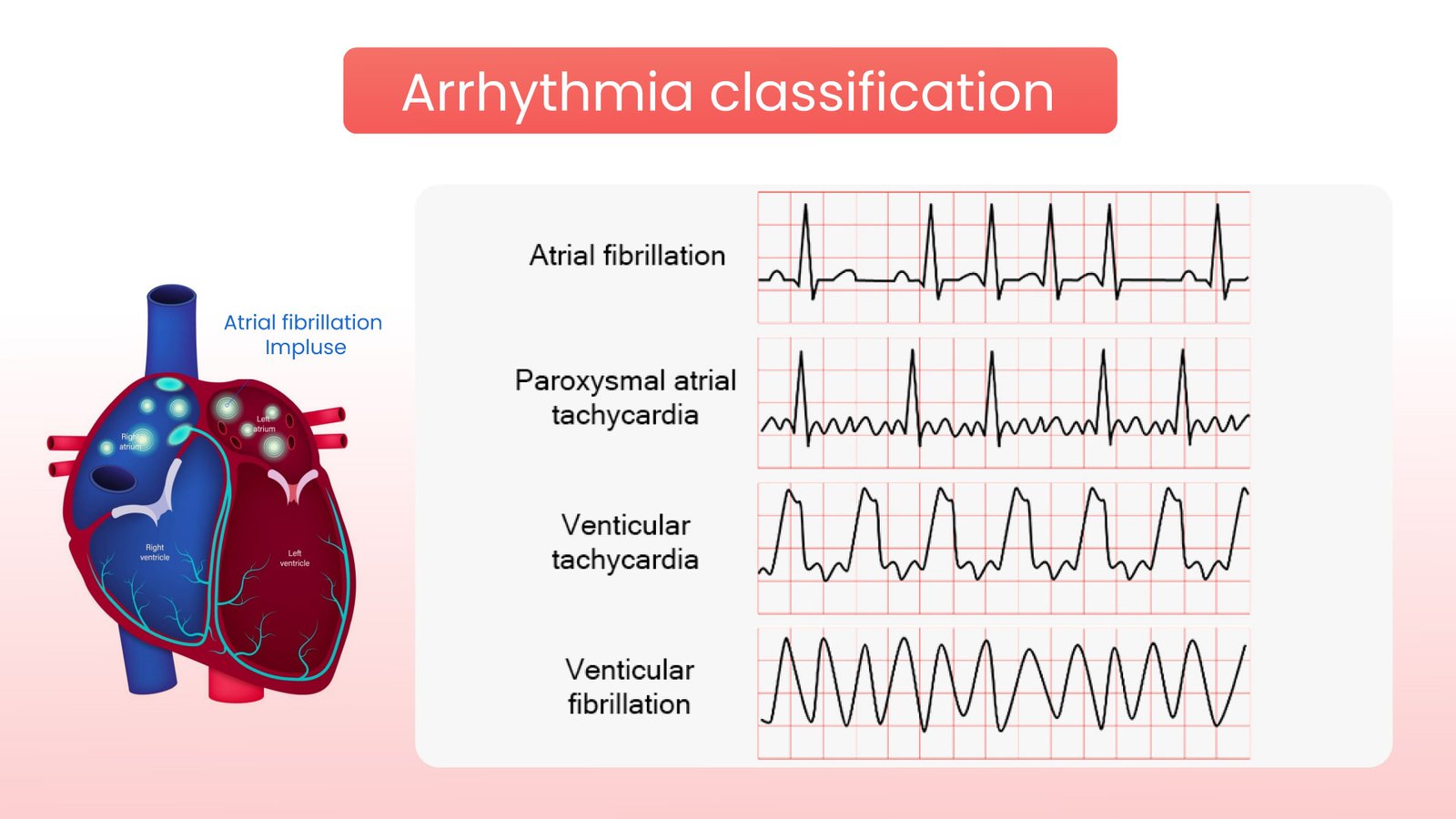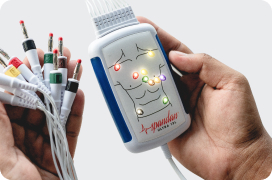
Author:- Mr. Ritesh Sharma
Arrhythmia refers to issues associated with the rate or rhythm of heartbeats. Arrhythmia classification is the categorization of types of arrhythmias. In this condition, the heart may beat too fast, too slow, or irregularly. While it is normal for the heart to respond to physical activities or rest at varied rates, problems arise when irregularities become frequent. Arrhythmia can induce feelings of dizziness and, in severe cases, lead to fainting. Fortunately, Arrhythmia categorized into various categories is highly treatable through medication and various procedures, requiring timely diagnosis and intervention.
What is Cardiac Arrhythmia?
The heart, as the life-pumping organ, operates through its natural pacemaker, the Sinoatrial Node (SA), generating a regular heart rhythm known as sinus rhythm. This rhythm is translated into electrical signals by the SA node, which travels through the heart’s conduction system, causing the atria and ventricles to contract and pump blood throughout the body. While this represents the fundamental understanding of heart rhythms, disruptions become apparent with symptoms like heart palpitations, slowing down of heartbeats, or irregular heartbeats.
Arrhythmia is the term used to define irregularities in heart rhythms. Despite appearing normal on the surface, it is a complex topic. Let’s delve deeper into the meaning of Arrhythmia, arrhythmia classification, causes, and diagnoses.
Significance of Understanding Heart Rhythms
A comprehensive grasp of Arrhythmia classification is crucial for early detection and necessary treatment, as irregular heartbeats should not be taken lightly. If left untreated, Arrhythmia can potentially damage the heart, brain, and other vital organs, leading to conditions such as stroke, heart failure, or cardiac arrest. Recognizing the significance of heart rhythms is essential for maintaining optimal cardiovascular health.
Arrhythmia Classification: Analyzing Heart Rhythms
Arrhythmia classification encompasses two main types based on their origin in the heart: Supraventricular and Ventricular. Let’s explore the detailed categorization.
Supraventricular Arrhythmias:
- Atrial Fibrillation: In this category of arrhythmia, the heart’s upper and lower chambers don’t work in harmony, causing the heart to pump less blood to the lungs and body. It is a potentially serious heart condition that requires prompt treatment.
- Atrial Flutter: The heart’s upper chamber beats 250-350 times per minute in this condition. This is because the electrical signal in the heart’s atria (the upper part) circulates rapidly causing an elevated heart rate which is characterized by the saw-tooth pattern on an electrocardiogram (ECG or EKG).
- Supraventricular Tachycardia (SVT): In this type of arrhythmia, the heart palpitation, beginning in the upper chamber of the heart. This condition can either be brief or prolonged depending on the severity. Seeking immediate medical assistance is crucial in prolonged SVT as it can seriously damage the heart.
- Atrioventricular Nodal Reentrant Tachycardia (AVNRT): A type of SVT taking place in the atrioventricular node. In this, the heartbeat becomes rapid and irregular. This happens due to the reentrant circuit within the atrioventricular (AV) node, which is a pivotal part of the heart’s conduction system.
Ventricular Arrhythmias:
- Ventricular Tachycardia: In this kind of arrhythmia, there is a fast beating of the ventricles. This type of tachycardia originates within the ventricles (lower part of the heart) which is a stark contrast to the SVT which originates above the ventricles.
- Ventricular Fibrillation: The heart beats rapidly within the ventricles in this classification of arrhythmia. The rapid beating of the heart prevents it from seamlessly pumping blood to various parts of the body causing a lack of oxygenated blood. If not treated timely, this medical condition can prove to be life-threatening.
- Premature Ventricular Contractions: In this category of cardiac arrhythmia, extra heartbeats occur abnormally in the ventricles. These extra heartbeats are premature and stem from the sinoatrial node, i.e. the natural pacemaker of the heart. These extra heartbeats disrupt the normal heart rhythm causing chaotic conditions in the cardiovascular system.
- Torsades de Pointes: A type of Ventricular Tachycardia characterized by abnormal ECG i.e. the lengthening of the QT interval in the ECG. The further worsening of Torsades de Pointes causes ventricular fibrillation.
Atrial Arrhythmias:
- Atrial Tachycardia: Rapid beating of the heart starting in the atrial region, i.e. the upper region of the heart. Atrial Arrhythmias hold some similarities to atrial tachycardia. However, unlike atrial tachycardia, the heart rate in it is organized and coordinated in this kind of arrhythmia.
- Sinoatrial Node Dysfunction: The heart’s natural pacemaker completely dysfunctions in this arrhythmia. Due to this, the heart’s rhythm abnormalities arise which causes a serious threat to the heart.
- Bradycardias: A third type of arrhythmia in which the heart rate goes below 60 BPM. These arrhythmias are of two types:-
- Sinus Bradycardia: This kind of cardiac arrhythmia originates in the sinus node, i.e. the natural pacemaker of the heart. This condition leads to various disturbances in the heart rhythm as it slows down and the heart rate goes lower than the normal range of 60 to 100 beats per minute.
- Heart Block: In this type of arrhythmia, conduction between the atria (upper chamber of the heart) and ventricles (lower chamber of the heart) is disrupted. This disruption leads to slow and blocked transmission of heart signals. There are three degrees of heart block- First Degree, Second Degree, and Third Degree.
Conduction Disorders:
- WPW (Wolf-Parkinson-White) Syndrome: This cardiac arrhythmia is characterized by an extra pathway between the atria and the ventricles. This pathway is called an accessory pathway or bundle of Kent. Due to this extra pathway, the electrical signals cannot pass through the AV note leading to a condition called pre-excitation.
- Long QT Syndrome: It refers to the prolonged QT interval on the ECG. The QT interval represents the time each heartbeat takes to depolarize and repolarize. This prolonged interval leads to the condition of torsades de pointes which, if further worsens, causes the life-threatening arrhythmia of ventricular fibrillation.
- Sick Sinus Syndrome: In this kind of cardiac arrhythmia, the heart’s natural pacemaker (Sinoatrial Node) doesn’t function properly. Because of this condition, the heart’s electrical impulses cannot be generated and transmitted properly. This causes various abnormalities associated with the heart’s rhythm.
Causes and Diagnosis of Arrhythmia
Arrhythmia is caused by various factors that disrupt the electrical activity of the heart. The following are the causes of Arrhythmia:
- Arrhythmia occurs when there is a delay or blockage of the electrical signals that form the heartbeat through contraction.
- The different categories of arrhythmia are caused when something substitutes the SA node, the heart’s natural pacemaker.
- Various types of cardiac arrhythmia can be caused due to stiffening or injuring of the heart tissues because of improper blood flow or disruption to the heart’s conduction system.
- Excessive stress, strain, or exertion can also cause arrhythmia.
- The imbalance of fluids, electrolytes, and hormones in the blood is also a major cause of various types of arrhythmia.
- Taking excessive heart medications can also disrupt its electrical activity and cause arrhythmia.
The most accurate diagnosis for different categories of Arrhythmias is possible through an Electrocardiogram (ECG/EKG). It provides an overview of the electrical activity of the heart, indicating irregular or abnormal rhythms, a major symptom of the medical condition. It is a painless medical diagnosis that uses a combination of electrodes to determine the heart’s electrical impulses. It shows abnormalities like p-wave ecg abnormalities, t-wave abnormality, QRS complex abnormalities, etc. Apart from this, arrhythmia can also be detected by several blood tests, echocardiography, exercise stress tests, etc. The detection of arrhythmia depends on the symptoms you are facing, hence before proceeding with any test, it is best to consult a medical expert.
Moreover, performing an ECG is easier than ever now with portable ECG devices allowing you to measure your heart’s electrical activity at home or on the go using a mobile application, without the hassle of having to visit hospitals frequently.
Arrhythmia is a condition that arises when there is an imbalance in the heart’s rhythm. However, with timely detection and treatment, it can be easily cured, and major risks caused by it can be prevented. Understanding the rhythms of the heart and the problems associated with it, with the right awareness and correct guidance, allows us to identify all the disruptions associated with the heart’s rhythm and maintain the ideal state of our heart health. If you ever suspect any category of arrhythmia it is best to consult a healthcare professional and seek worthy advice.





